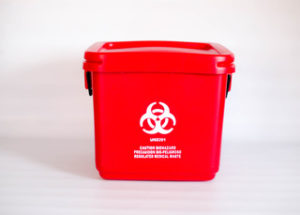Browsing Safety: The Important Overview to Medical Waste Disposal Finest Practices
Browsing Safety: The Important Overview to Medical Waste Disposal Finest Practices
Blog Article
Discovering Various Waste Disposal Options for a Cleaner Setting
In the search of a cleaner setting, the administration of waste disposal has arised as a critical focal point for sustainable growth. With a wide range of waste disposal alternatives available, ranging from traditional land fill methods to cutting-edge waste-to-energy modern technologies, the selection of how we manage our waste has far-reaching implications for our earth's health.
Recycling Approaches
Executing effective recycling approaches is crucial in reducing waste and advertising sustainability in our atmosphere. Reusing involves the process of converting waste products right into multiple-use challenge prevent unneeded disposal. Among one of the most typical recycling techniques is worldly healing, where products like paper, steel, glass, and plastic are collected, sorted, and processed to create new products. This procedure not only conserves natural deposits but additionally minimizes power usage and greenhouse gas discharges related to generating new materials from the ground up.
An additional important recycling approach is composting, which involves breaking down organic waste like food scraps and lawn trimmings right into nutrient-rich dirt. By integrating these different reusing techniques right into our waste management methods, we can dramatically decrease our ecological footprint and move in the direction of a more lasting future.

Composting Techniques
Reliable waste management techniques, such as recycling methods, pave the way for a cleaner environment, and currently, moving the focus to 'Composting Techniques', we check out sustainable methods to disintegrate natural waste for environmental advantage. medical waste removal service.
Composting is an all-natural process that transforms natural waste, like food scraps and yard trimmings, right into a nutrient-rich dirt modification. The key to effective composting hinges on creating the ideal equilibrium of eco-friendly products, such as fruit and vegetable scraps, and brownish materials, like dried fallen leaves and branches. These products decompose with the help of microorganisms, damaging down the waste into important garden compost.
There are numerous composting techniques offered to fit different requirements. Conventional backyard composting includes layering natural materials in a container or stack and consistently turning the mixture to aerate it. Vermicomposting, on the other hand, makes use of worms to break down raw material right into compost (click here). For those with restricted room, indoor composting systems give a practical option. By using composting methods, we can reduce the quantity of waste sent to landfills while developing a valuable product for enhancing dirt and supporting plant growth.
Incineration Disadvantages and pros
Incineration, as a waste disposal approach, provides both benefits and negative aspects that warrant mindful consideration in the world of sustainable waste management practices. On the positive side, incineration can substantially reduce the volume of waste, lessening the need for landfill space and potentially decreasing greenhouse gas emissions. Incineration additionally permits the recovery of energy via the generation of electrical energy or heat, adding to resource healing. Additionally, the process can be made use of to ruin hazardous materials, providing a secure approach for handling certain types of waste that might pose threats to public health news and the environment if left without treatment.
In addition, the high initial investment and operational costs of incineration centers position economic difficulties, making it a much less cost-efficient alternative contrasted to various other waste monitoring strategies. Careful tracking and policy are important to mitigate these adverse effects and take full advantage of the advantages of incineration as part of a detailed waste monitoring strategy.
Landfill Monitoring Approaches
Land fills play a critical role in waste management and ecological preservation by supplying a containment system for the disposal of strong waste products. By condensing the waste, the quantity is reduced, enabling for more waste to be suited over time.
In addition, the execution of day-to-day cover methods is essential in minimizing odors, stopping trash, and lowering the attraction of pests. Covering the disposed waste at the end of each day aids to contain odors and protect against prospective environmental contamination. Furthermore, the tracking of land fill gas emissions and leachate degrees is crucial in guaranteeing that environmental requirements are met and that any potential threats to surrounding environments are reduced.

Waste-to-Energy Technologies
One of the ingenious approaches to lose administration includes harnessing Waste-to-Energy innovations to convert strong waste into functional power resources. Waste-to-Energy (WtE) technologies incorporate a variety of processes that aim to remove energy from waste products with thermal, chemical, or organic methods. This conversion process not just reduces the quantity of waste that winds up in landfills yet likewise produces useful power sources such as power, warm, or biofuels.
Incineration involves melting waste at high temperatures to produce warmth and electricity. Gasification transforms waste right into a syngas, which can be made use of for power generation or chemical production.
Carrying out Waste-to-Energy technologies can aid mitigate ecological issues connected with standard waste disposal techniques while concurrently offering a renewable resource resource. Nonetheless, mindful consideration must be provided to emissions control and guaranteeing the sustainability of feedstock supplies for these technologies to be genuinely useful for a cleaner atmosphere.

Conclusion
To conclude, discovering numerous waste disposal options such as reusing, composting, incineration, land fill administration, and waste-to-energy technologies is vital for advertising a cleaner atmosphere - click here. Each method has its very own advantages and obstacles, however by using a combination of these techniques, we can function in the direction of decreasing the amount of waste that winds up in land fills and inevitably add to a more lasting future for generations to find
With a multitude of waste disposal choices readily available, ranging from standard garbage dump approaches to ingenious waste-to-energy technologies, the option of exactly how we handle our waste has far-ranging implications for our earth's wellness. medical waste removal service.Incineration, as a waste disposal approach, offers both benefits and negative aspects that merit careful factor to consider in the world of sustainable waste monitoring methods.Garbage dumps play an essential role in waste monitoring and ecological conservation by providing a containment system for the disposal of solid waste materials. By compacting the waste, the quantity is reduced, allowing for more waste to be suited over time
One of the cutting-edge approaches to lose monitoring involves using Waste-to-Energy innovations to convert strong waste into functional energy sources.
Report this page